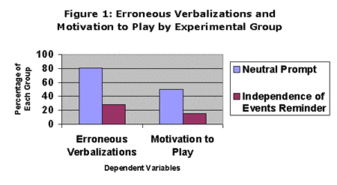The temptation to assume that the odds of a particular random-outcome event (e.g., obtaining heads when flipping a coin) change based on previous outcomes (e.g., a series of tails) is well-documented (see WAGER 9(19)). This cognitive distortion, called the gambler’s fallacy, is widespread and a part of the conventional wisdom. Even people who understand that random events are independent seem to forget it when they gamble. Research has shown that problem gambling is associated with these cognitive distortions (Ladoucer & Walker, 1996), so one method for targeting gambling problems includes limiting these irrational beliefs through safeguards built into games. This week the WAGER presents a recent study by Benhsain, Taillefer, and Ladouceur (2004). This study examined the influence of reminder messages on erroneous cognitions (i.e., committing the fallacy) and the motivation to gamble.
Through newspaper advertisements, the researchers recruited 18 men and 13 women who met criteria for being “occasional players”; they reported participating in gambling games other than the lottery at least once every two months, and considered themselves occasional gamblers. Prior to the experiment, the researchers taught all participants about the independence of events, a common cognitive distortion for gambling.1 Specifically, they informed participants that events, like gambling games, are independent and, as chance events, not connected to a preceding or subsequent event. The experiment required participants to verbalize their thoughts while participating in an American roulette game. After an instruction session to explain the gambling game and verbalization procedure2, the researchers gave participants the opportunity to bet on a minimum of 15 games with $10 (CAN). Researchers assigned participants to two conditions where, once every 5 games, the participants saw and read aloud either a neutral message (i.e., control condition) or a reminder message about independence of random events (i.e., experimental condition) (3).
The researchers monitored the verbalizations and noted whether or not the participant indicated that a betting choice was influenced by the fallacy of non-independence. The researchers categorized participants as motivated to play if they continued to play beyond the mandatory 15 games. Table 1 shows the proportion of subjects in each group who verbalized embracing the gamblers’ fallacy at least once and the proportion of subjects who chose to play more than 15 times.
Figure 1 shows the statistically significant differences between the experimental (i.e., group that was given a reminder) and control groups (i.e., group not given a reminder) for verbalizations (t(29)=7.86, p<0.001) and motivation to play (.2 (1)=5.03, p<0.05).
Study limitations included several factors. The authors did not distinguish between those who were winning at the end of 15 and those that were losing. A participant’s winning streak could have influenced the motivation to continue gambling as much the visual reminder. Furthermore, the authors did not report the content of the reminder message shown to the experimental group. Next, although authors reported the contents of the message shown to the control group, it is possible that the “neutral message” might have encouraged further play. To eliminate this possibility future research should include a no message group.
This study suggests that visual reminders can reduce erroneous cognitions. Cognitive distortions have been associated with the presence of gambling disorders (Ladoucer & Walker, 1996); consequently, visual reminders might be useful to reduce gambling disorders. For example, perhaps casinos and lotteries could use various visual reminders to reduce erroneous cognitions – or limit the development of such cognitions – that are associated with casino or lottery gambling. Given the promise of visual reminders, future research should examine the utility of other types of reminders (e.g., audio) and methods (e.g., subtle or obvious) to reduce or prevent the erroneous cognitions that are associated with gambling disorders.
Comments on this article can be addressed to Michael Stanton and Debi LaPlante.
Notes
1 Many individuals mistakenly believe that the outcome of an event, like a slot machine pull, is in some way dependent on the outcome of preceding events (e.g., slot machine pulls); however, each pull represents a new game with identical odds of winning or losing as the prior game. Strategies on these types of games are futile.
2 “The thinking aloud method consists of verbalizing every thought that passes through your mind while playing.” (Benhsain et al., 2004)
3 The authors reported the content of the neutral message (i.e., “push on OK to continue”), but not the experimental reminder message.
References
Benhsain, K., Taillefer, A., & Ladouceur, R. (2004). Awareness of independence of events and erroneous perceptions while gambling. Addictive Behaviors, 29, 399
404.
Ladoucer, R., & Walker, M. (1996). Cognitive perspective on gambling. In P. M. Salkovskis (Ed.), Trends in cognitive therapy (pp. 89-120). Chichester, UK: Wiley.





